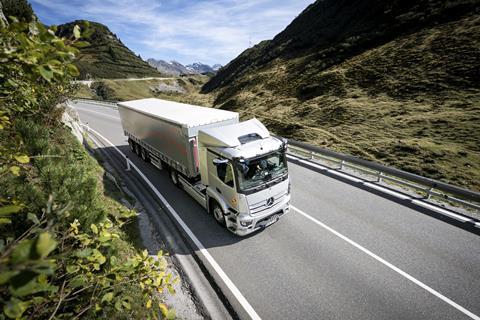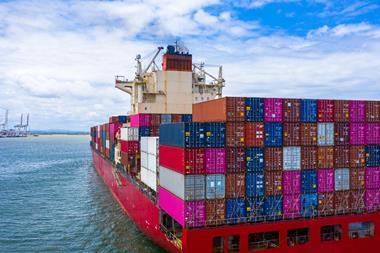1.5 trucks in Europe will be attacked during the time it takes to read this article. Pascal Matthey, VP, Marine Risk Control, Continental Europe at Sompo explores what risk managers can do to tackle the issue
Ever since the first caravans across continents began more than 2,000 years ago, goods in transit have always been a target for thieves.
The threat has evolved exponentially since then: with millions of shipments underway at any one time, the complexity of today’s supply chains and the new tactics deployed by criminal organisations, combining to create a rapidly changing risk environment.

With disruption of supply chains becoming a key strategy of modern-day warfare, threats to the security of the transport system, cargo and, most importantly the safety of drivers, are top of mind for risk managers.
According to figures from the International Union of Marine Insurance (IUMI), thefts account for about 14% of all cargo insurance claims. And, worryingly, statistics suggest that one in three drivers will be attacked during their lifetime.
Robberies are relatively commonplace - 1.5 trucks somewhere in Europe will be attacked during the time it takes to read this article.
But while the problem of on-road robberies is troubling, there are steps that logistics managers and their risk manager counterparts can take to bolster cargo security and driver safety.
The problem in Europe
The time that goods are in transit, typically between two better-protected sites, has always been a weak link in the chain and is a problem the world over.
In Europe, however, there are some particular trends around which risk professionals are keen to increase awareness and improve resilience.
Road crime is most often committed by organised gangs, although careless behaviour can sometimes prompt opportunistic theft. Almost any item that has a resale market is a target for theft. And the uptick in e-commerce means that many desirable goods for which there is a ready black market are on the roads at any given time.
The most targeted products are: food and beverage; household electronics; metals; pharmaceuticals; and home or garden materials.
In Europe, it is estimated that an average €1.34 million worth of goods is lost per day and the value of the average insurance claim is about €256,000.
“Road crime is most often committed by organised gangs, although careless behaviour can sometimes prompt opportunistic theft.”
Thefts tend to take place in unclassified parking areas, at or close to the origin facility, or during transit. They include stealing directly from a truck, intrusion into a warehouse, armed robbery, theft of a vehicle, hijacking and thefts from containers.
Although data about the volume of thefts in some regions is patchy, the European countries where most threats are reported are Germany, the UK, Italy, France, Spain and Sweden.
Robberies tend to take place near ports or large urban conurbations. In the UK, the area close to Birmingham where several major motorways converge and numerous logistics hubs have sprung up, is a particular hotspot.
More widely, a lack of official parking spaces across Europe is a major problem, leaving trucks vulnerable overnight - when most robberies take place.
In Switzerland, the risk of road robbery is considered relatively low, although there are no official statistics.
However, vehicles in Switzerland are often carrying luxury goods that are attractive targets for thieves, and the fact that heavy trucks - which often would be armoured - are not allowed to drive between the hours of 10pm and 5am increases the risk of theft at night while they are parked.
Evolving theft trends
There are several tried and tested modus operandi for road robberies. In Latin America and Africa, techniques include hijacking and armed robbery and thefts are usually highly targeted and not opportunistic.
In Europe, however, theft from a truck during an overnight stop is a common tactic. Thieves often target vehicles when drivers are resting and break up trailers or containers to steal their contents.
“An acrobatic form of theft whereby criminals climb onto a car bonnet while in motion and use a tool such as a crowbar to break into a moving truck is becoming more frequent”
A trend that has become particularly prevalent in the UK is for criminals to set up fake police controls, forcing drivers to stop. The criminals then assault the driver and unload the truck’s contents into a vehicle of their own.
Thieves are also getting increasingly audacious - an acrobatic form of theft whereby criminals climb onto a car bonnet while in motion and use a tool such as a crowbar to break into a moving truck is becoming more frequent. Often thieves use a second vehicle to slow the truck down.
Another developing trend is the emergence of strategic theft. Diverting trucks by giving fake documentation, for example, or creating fictitious carriers or fake driver identities can enable thieves to steal goods and disrupt supply chains without a direct attack.
Best practice
Although road robbery is a major concern, there are steps that companies can take to mitigate some of the risks they face. These include avoiding regular schedules so that it is more difficult for thieves to know when, where and what to target.
They also should be mindful of carefully selecting their carriers, thoroughly checking driver IDs and ensuring that trucks are fully refuelled to minimise the need for stops.
It’s also vital that itineraries and overnight stops are agreed in advance, driving times are checked and information is kept on a “need-to-know” basis.
There are security measures that can be taken too, notably the Transported Asset Protection Association (TAPA) trucking security requirements (TSR).
Locks and seals should be checked, GPS tracking used and radio liaison between the driver and a central control hub frequent and clear.
It’s also advisable that a customs’ cord is used to secure the curtain of the truck to its body, that drivers keep their cabin locked at all times and that they park their vehicle against another truck, wall or fence to restrict potential access points.
Driving forwards
Road crime is as old as road transport, and shows little sign of disappearing. But there are various ways to reduce the threat. And insurers can work with clients to help them assess, manage and mitigate these risks where possible.
In Europe, where an estimated shortfall of about 100,000 secure parking spaces is a significant concern, there are various initiatives to try to address this and we add our voice to those calling for solutions to this problem to keep drivers safer and cargos secure.











No comments yet